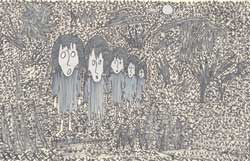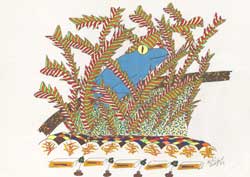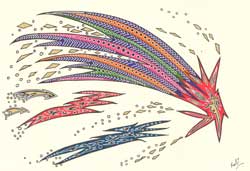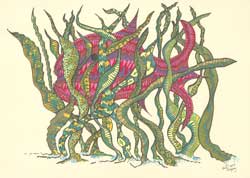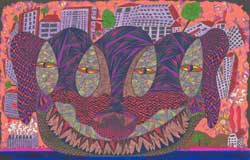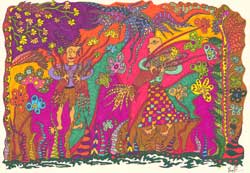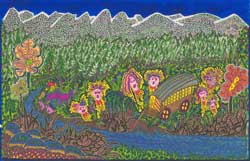DISCUSSION
You might want to read the novel first before reading the following.
Gamboa: a God on Earth. He is the Chosen One. He is immortal. He dies but is reincarnated to lead his tribe.
Twelve Priests: represent the twelve Disciples of Christ.
The Apprentice, Xirqutz Xirqutz: represents Judas. He makes a deal with the Devil (Aztec Goddess Chaltexla), betrays Gamboa and wants to take his place.
Gamboa, Jaxxa and Lazarus: the Holy Trinity. Father, Son and Holy Ghost.
Kitsune: Mary, mother of Christ, a healer and Saint.
Lazarus’s family: martyrs, prophets and spiritual guides. Punished and slaughtered for their beliefs.
Gamboa’s son: sacrificed. Allusion to Abraham and God’s direction.
The Vial: chalice or holy grail.
The Box: Arc of the Covenant, lost at sea.
Magic birds and force of nature: visions and dreams of the Old Testament.
Lazarus and Kitsune’s house: search for lost Paradise on earth.
Trentham’s resurrection: miracles, raising of the dead.
Destruction of the Beach Paradise: God is unhappy and destroys the world.
Gamboa bathing in the river: baptism.
NAMES IN THE NOVEL
It would have been easy to delve into Mayan and Aztec history and steal names from their past. I don’t know about you but I find complicated, incomprehensible names a real pain when reading a story. So, a decision was taken to use modernish names, pronounceable, yet with a flavour of the exotic.
Gamboa
Clearly this is a modern Hispanic sounding name and I chose it deliberately as the character transcends time and geography. I am aware that he would have had a name perhaps more antiquated (and probably much more complicated) but I wanted a name with which readers would feel comfortable. Should Wo-Sak, The Frog God ever be translated into Spanish or Basque (the true origin of the name) I suppose there will be many who will complain that it is too modern and most unlikely. For the average reader, however, the name serves. Gamboa means “peak” “zenith” or “summit”. Either way, it suits the character well enough. He is top dog! (or frog!)
Wo-Sak
This is a combination of names of the Mayan Astrological Zodiac.
Wo (Uo): August 15 - September 3
Sak: (Sac or Zak): February 11 - March 2
Both these signs have the frog as their animal totem. Those born under the sign of Wo are gifted with the ability to shift between levels of consciousness and are prone to seek out mystical wisdom and mysteries. Those born under Sak have the frog as a power totem, being adaptable and at ease with change - just like the frog. The combination of these two signs seemed an appropriate name for the principal Frog God.
Chaltexla
The Goddess Chaltexla actually exists in a much more ornate fashion as Chalchiuhtlicue. She is the Aztec Goddess of water. Her name means: She Who Wears a Jade Skirt. Clearly the root of the name is evident but for the convenience of the modern reader her name has been simplified. Apologies to the true aficionados of ancient mezzo-American culture.
Tsok, Chatlan, Jaxxa and Xurqutz Xurqutz
All made up names. Any similarity between these names and others in history is entirely coincidental.
Kitsune
Japanese word for fox. They are commonly found in folktales and have magical abilities.
Lazarus
Perhaps of Greek origin, it means “God has helped” or “God has been my help”. Of course, in the Bible Lazarus was raised from the dead.
Hercules
The Greek hero Heracles became the Roman Hercules. He is famous for his great strength and fantastic adventures.
Sabrina
In Arabic the name Sabrina is associated with “patience”. In Hindi and Punjabi, it means “everything”.
Bulut
Turkish in origin, this name means “cloud”.
A’isha
Popular in various cultures, A’isha refers to “one who lives’, is “womanly” and “vivacious”.
Ghengis Khan
A true historical character who forged one of the biggest empires the world has ever seen.
Mary Kelly
Mary Kelly was the final victim of Jack the Ripper. Her heart was never found. Just who Jack the Ripper was has been the subject of speculation for over one hundred years.
George Bagster Philips
Nicknamed Baggy in the novel, Bagster Phillips was the medical officer on the scene of Mary Kelly’s murder.
Inspector Abbeline
Abbeline was tasked with finding the serial killer Jack the Ripper. To his great frustration, he failed. He was also on the scene at the murder site.
HoLmes and Dr Watson
Fictitious, but greedy to appear in lots of novels, these two names pop up all over the face of literature - as they do here, albeit very briefly.
Hernan Cortez
This Conquistador was indeed very real. He was responsible for the destruction of the Aztec Empire and near obliteration of their entire culture.
General William Booth and The Salvation Army
William Booth founded the Salvation Army in 1865 in the East End of London. It still exists today as a religious organisation with a quasi-military format.
SETTINGS, NAMES, PLACES and EVENTS
The novel opens on a tropical coast somewhere, sometime in prehistory. It could have been just about anywhere but it has, as its future, the rise of the Mayan empire and later the Aztecs. Therefore, the original setting is the Gulf of Mexico. The city of Suxx rises and falls, eventually disappearing with the drought which blights the fictitious city. It disappears, then the real historical Mayans rise, followed by the Aztecs.
Why the Mayans just got up and left their great cities has been the subject of many studies and no explanation has been rendered water tight. The most popular reason given for their demise is drought - this I have used as the source of the decline and fall of the original (fictitious!) city of Suxx.
Acatitlan
This ancient Aztec site really does exist some miles to the north of today’s Mexico City.
St Helen’s Church, Westcliffe-on-Sea, Essex
The Catholic church in the novel was founded in 1862 and built in 1867. St Helen (or Helena) of Greek origin, is credited with finding the cross of Jesus.
Mucking
This small, Essex village sits about the Thames Estuary and has a long, proud history.
Savoy Theatre and Gilbert and Sullivan
Gamboa and Jaxxa go to the Savoy Theatre, London, and see a performance of a new opera, The Yeoman of the Guard. Gilbert and Sullivan did indeed offer up this comic musical at the time of the novel’s setting and the Savoy was the first theatre to boast electric lights.
Wetheringdon Hall
Entirely fictitious, yet based on the many great mansions scattered about London and the Thames.
Utopium, Limehouse
Limehouse, still thriving today, is situated in London’s East End. The Utopium, on-the-other-hand, is entirely the product of the author’s imagination - although opium dens did certainly exist and Sherlock Holmes did frequent them.
Krakatoa
In 1883, the Indonesian volcanic island of Krakatoa did actually explode in a ferocious eruption. Over 35,000 people were killed and weather patterns worldwide were changed for some time afterwards.
River Thames Pollution
It is well documented that during Victorian times in the mid 1800s, the River Thames in London was so polluted with human waste and industrial effluent, that outbreaks of cholera were blamed on its contamination.

